Chocolate
Chocolate is highly toxic to cats and dogs, contains the bromine which is a toxic substance taken in excess, (80 - 100 gr. Of chocolate consumed per kilo of animal, the consequences can be fatal) causes rapid heartbeat, diarrhea, vomiting, systemic failure, coma and death can result. In animals the bromine very slowly eliminated from your body so if the animal ingests chocolate continuously, even small amounts, never remove the substance and when it comes to the amount that is toxic to your body would cause intoxication. The black chocolate contains much more amount of the bromine.
it is often said that the cat is to give milk, but is another of the old myths about cats. The cat's digestive system after being weaned, start not tolerates lactose. So never give cat milk can cause diarrhea, vomiting and other digestive problems.
Bone and bones
the bones, especially poultry, splinter very easily and that can cause tears and esophageal and intestinal obstruction, as happens with fish bones.
Salted meats and sausages
Salted meats have a higher salt concentration than the cat's body can accept and can cause severe hypertension and systemic problems. The addition of salt meats contains a high amount of fat that could provoke pancreatitis.
Alcohol
Alcohol causes a lot of toxicity in animals, urinary incontinence and more problems. A large amount of alcohol can cause death of the animal.
Onions, shallots, leeks and garlic
it is very toxic to dogs and cats. Contains substances that remove the red cells of the blood and cause hemolytic anemia and the results can be fatal.
Avocados
it contains much fat, especially pulp, could cause serious stomach problems and pancreatitis.
Caffeine
Caffeine is a stimulant of the nervous system in an animal's reaction is much higher and, like chocolate, it causes serious nervous system disorders and heart rate, vomiting, diarrhea and even death.
Tuna human consumption
the tuna itself is not a toxic product for the cat, what happens that lacks turbine, an essential amino acid necessary for the proper functioning of the heart, sight and many more organs. If tuna is given routinely to provide this essential amino acid not ultimately has serious heart problems. In the cat there are cans of tuna that were previously added turbine.
Raisins and grapes
they can cause kidney failure.
Products sweetened with xylitol sugar and
Sweetened products are harmful to animal health and xylitol products are toxic.
Nuts
containing salt or not, are totally discouraged in animals, causing kidney failure, vomiting, diarrhea and digestive problems.
Raw fish
In addition to containing the parasite called Anisakis, which only removes cooking it or very low temperatures; it also contains an enzyme that causes vitamin B in the body.
















